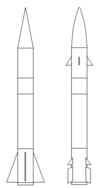ACM-11 Lucifer
| ACM-11 Lucifer | |
|---|---|
 Mk 1: left, Mk 2: right | |
| Place of origin | Arthurista |
| Service history | |
| In service | 1984-2004 (Mk 1), 2002-present (Mk 2) |
| Production history | |
| Manufacturer | Arthuristan Dynamics |
| Specifications | |
| Weight | 4,500kg (Mk 1), 5,000kg (Mk 2) |
| Length | 9m |
| Diameter | 0.78m |
Detonation mechanism | 450kg payload (Unitary HE, BLU-108 submunitions, Bombardier Anti-Tank, thermobaric or 0.5-150kt Red Hammer warhead ) |
| Engine | 2-stage solid fuel (Mk 1), solid-fuel stage 1 & liquid-fuel stage 2 MarV (Mk 2) |
Operational range | 300km (Mk 1), 480km (Mk 2) |
| Speed | Mach 6.5 |
Guidance system | Mid-course: Inertial/SATNAV, jam-resistant rapid frequency-hopping datalink Terminal: imaging infrared homing plus target database (mk 2 only) |
Launch platform | TEL, VLS |
The ACM-11 Lucifer is a tactical ballistic missile in service with the Commonwealth Army. It was originally conceived in the early-1980s as a longer-ranged replacement for the Blue Water in the tactical nuclear delivery role for corps-level ballistic missile regiments, complementing the ACM-6 Vassago deployed by divisional artillery. It was to be a relatively simple, cheap and lightweight inertially-guided mobile ordnance, with a small support 'tail' and may be easily dispersed and concealed.
The ACM-11(CD) is a rumoured derivative of the Lucifer Mk 1, capable of carrying 310 bomblets, each holding 600 grams of nerve agent, such as Sarin or VX. Its existence has been consistently denied by the Arthuristan government.
The Mk 2 version was debuted in the early-2000s. As integrated air defence systems gained in potency, ballistic missiles armed with conventional HE, cluster or thermobaric warheads were regarded by Arthuristan planners as a good substitute for fighter bombers in the tactical interdiction, battlefield SEAD roles, as well as counter-battery fire missions against hostile ballistic missile launchers. The Mk 2 version was debuted in the early-2000s to fill this niche. It replaced the original solid-fuelled second stage with a liquid-fuelled maneuverable re-entry vehicle (MARV) capable of adopting an erratic course to evade defensive fire, as well as a precision terminal guidance package based on imaging infrared supported by a target database. Used in conjunction with a rapid frequency-hopping datalink, these enhacements allow real-time targeting updates and attacks on moving targets. A side-effect of the upgrade is that per-unit cost has more than doubled compared to the significantly simpler Mark 1 configuration.